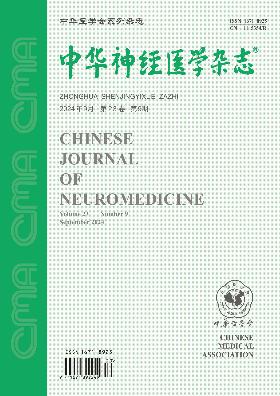Correlations of high mobility group protein box-1 level with severity and prognoses of acute cerebral infarction
Q4 Medicine
引用次数: 0
Abstract
Objective To investigate the correlations of high mobility group protein box-1 (HMGB1) level with severity and prognoses of acute cerebral infarction. Methods Between April 2018 and October 2018, 300 patients with acute cerebral infarction and 122 healthy control subjects were enrolled. According to National Institute of Health stroke scale (NIHSS) scores, patients with acute cerebral infarction were divided into group A (NIHSS scores 2) after 3 months of follow up. The serum levels of HMGB1, low density lipoprotein cholesterol (LDL-C) and high density lipoprotein cholesterol (HDL-C) in different groups were detected and compared. Pearson correlation analysis and receiver operating characteristic curve were used to analyze the correlations of serum HMGB1 level with other indicators and evaluate their predictive values in poor prognosis. Results The serum HMGB1 level in the acute cerebral infarction patients was significantly higher than that in the controls ([7.98±3.99] μg/L vs. [4.61±1.02] μg/L, P<0.05); the serum HMGB1 level in the group C was significantly higher than that in group B ([12.86±1.91] μg/L vs. [7.30±1.07] μg/L, P<0.05), and that in group B was statistically higher than that in group A ([7.30±1.07] μg/L vs. [3.78±0.95] μg/L, P<0.05). Serum HMGB1 level was positively correlated with LDL-C level and NIHSS scores (r=0.521, P=0.000; r=0.931, P=0.000), and negatively correlated with HDL-C level (r=-0.114, P=0.001). The serum HMGB1 level in good prognosis group was significantly lower than that in poor prognosis group ([6.52±3.29] μg/L vs. [9.88±4.03] μg/L, P<0.05), and the serum HMGB1 level was positively correlated with mRS scores (r=0.160, P=0.000). The area under the curve of HMGB1 predicting poor prognosis of acute cerebral infarction (0.736[95%CI: 0.677-0.795]) was larger than that under the curve of LDL-C predicting poor prognosis of acute cerebral infarction (0.634[95%CI: 0.570-0.698]). Conclusion Serum HMGB1 level in patients with acute cerebral infarction is significantly increased, which is related to severity of disease, and has certain predictive value in prognoses of acute cerebral infarction. Key words: High mobility group protein box-1; Acute cerebral infarction; Disease severity; Prognosis高迁移率组蛋白box-1水平与急性脑梗死严重程度及预后的相关性
目的探讨高迁移率组蛋白盒-1 (HMGB1)水平与急性脑梗死严重程度及预后的相关性。方法2018年4月至2018年10月,选取300例急性脑梗死患者和122例健康对照者。根据美国国立卫生研究院卒中量表(NIHSS)评分,随访3个月后将急性脑梗死患者分为A组(NIHSS评分2分)。检测各组大鼠血清HMGB1、低密度脂蛋白胆固醇(LDL-C)、高密度脂蛋白胆固醇(HDL-C)水平并进行比较。采用Pearson相关分析和受试者工作特征曲线分析血清HMGB1水平与其他指标的相关性,评价其对不良预后的预测价值。结果急性脑梗死患者血清HMGB1水平显著高于对照组([7.98±3.99]μg/L vs[4.61±1.02]μg/L, P<0.05);C组患者血清HMGB1水平显著高于B组([12.86±1.91]μg/L比[7.30±1.07]μg/L, P<0.05), B组患者血清HMGB1水平显著高于A组([7.30±1.07]μg/L比[3.78±0.95]μg/L, P<0.05)。血清HMGB1水平与LDL-C水平、NIHSS评分呈正相关(r=0.521, P=0.000;r=0.931, P=0.000),与HDL-C水平呈负相关(r=-0.114, P=0.001)。预后良好组患者血清HMGB1水平显著低于预后不良组([6.52±3.29]μg/L比[9.88±4.03]μg/L, P<0.05),且与mRS评分呈正相关(r=0.160, P=0.000)。HMGB1预测急性脑梗死不良预后曲线下面积(0.736[95%CI: 0.677 ~ 0.795])大于LDL-C预测急性脑梗死不良预后曲线下面积(0.634[95%CI: 0.570 ~ 0.698])。结论急性脑梗死患者血清HMGB1水平明显升高,与病情严重程度有关,对急性脑梗死预后有一定的预测价值。关键词:高迁移率蛋白盒1;急性脑梗死;疾病严重程度;预后
本文章由计算机程序翻译,如有差异,请以英文原文为准。
求助全文
约1分钟内获得全文
求助全文
来源期刊

中华神经医学杂志
Psychology-Neuropsychology and Physiological Psychology
CiteScore
0.30
自引率
0.00%
发文量
6272
期刊介绍:
 求助内容:
求助内容: 应助结果提醒方式:
应助结果提醒方式:


